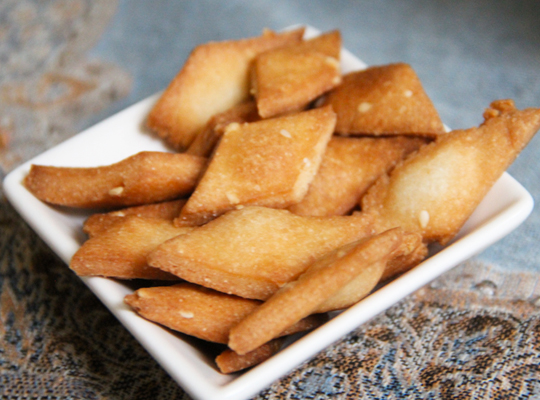Mama’s Punjabi Recipes: Shakkar Parre (Fried Sugary Flour Sticks)
A few snacks which are made to be salty can also be made in the sweet version with just a few adjustments and of course, the taste is quite different. This switch works quite well with matthis (fried salty cookies) and namkeen mutter (fried salty peas) which are also called namkeen parre (fried salty sticks).
There is usually a huge demand for all three snacks, especially during the winter months, to nibble on over hot tea. This is a tradition that probably grew out of the olden days when people in towns and villages would make pippas (tall, shiny tin boxes with wire handles on top and the sides to carry) full of them. You could easily store a huge supply of these three, and other, snacks to carry the family through the cold winter, especially since families were mostly rural and agrarian and also very large. It was not uncommon for families to have 7 to 10 members! Once the families moved to cities, like mine after the Partition, the tradition moved along with them.
The reason why these three snacks are so popular is that they are cheap and easy to make, but also they are nutritious after a hard day’s work, can fill you up fast and – most of all – taste good. The texture defines the taste: I think the crispier, the better, but softer, fluffier ones are also available.
Unlike the namak parre, the shakkar parre are hard and become harder when kept for long months. Usually they are made of maida (bleached white flour), and then dipped in sugar syrup. They can also be dipped in melted gur (jaggery) which gives them a brown color, and are called gur parre.
Ingredients :
2 cup maida (bleached, white self-rising flour)
3/4 cup tael (oil: sunflower or canola is best)
1 1/2 cup pani (warm water)
1 cup chinni (sugar)
1 tsp namak (salt)
Tael (oil) to fry the dough in
Directions:
1. In a large bowl, pour in the maida and the oil, mix well and knead the mixture with your hands.
2. Add some warm water to make the dough a little hard.
3. Take some dough and roll into a 2 inch ball. Flatten it with a rolling pin till it is round and about 1/4 inch thick.
4. Take a sharp edged knife and cut strips of the dough, about ½ inch wide. Then cut diagonally across to make 4 inch long pieces that resemble peas in pods: hence the name mutter (peas).
5. Continue to roll out the rest of the dough as you finish off each batch.
6. Heat ½ cup of water in a saucepan and stir in the sugar. Let the mixture come to a boil over medium heat so that the sugar is completely dissolved and turn the heat off.
7. In a kadai or wok, warm some oil over medium heat. When hot, gently slip the cut pieces of dough into the oil and fry till they are golden but not very brown.
8. Take out of the oil with a slotted ladle and gently drop the parre into the chasni (syrup), swirling so that they get well coated with the syrup.
9. Take out of the syrup and place in a plate. Once the parre have cooled down, separate them with a wooden spoon. You can store them in a container with a tight lid and they will keep for many weeks.
MAMA’S TIP OF THE WEEK
IF NOTHING ELSE IS AVAILABLE, USE HALDI FOR COLORING DISHES
Many Indian sweets are either white – the color of the milk which is its base ingredient as in burfi or rus malai or rus gulle – or fried and golden brown, like khoya (coagulated and browned milk). Other Indian sweets are more colorful, and adding a little color enhances its appeal.
Sometimes the dish can ask for a little saffron to add color and a little extra taste, but when all else fails and you don’t have coloring available, just throw in a dash of haldi (turmeric) to bring out the same look. You can do this with halva, ladoos, jalebis or mitthe chawal, but generally haldi is used for saltly dishes.
Shakuntla Malhotra is a skilled cook of Punjabi dishes made in the old-fashioned style that she learnt as a young woman in her ancestral home in Lyallpur, India before it became part of Pakistan after the Partition in 1947. People have often admired her cooking for its simplicity and taste that comes with each mouthful. Even in her mid-eighties, she continues to cook daily and agreed to share some of her delectable Punjabi recipes.


